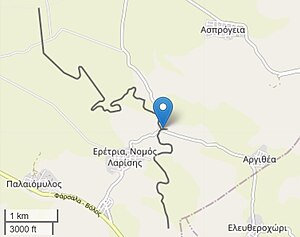Rigeo – Eretria light railway
| Rigeo – Eretria light railway | |||||||||||||||||||||||||
|---|---|---|---|---|---|---|---|---|---|---|---|---|---|---|---|---|---|---|---|---|---|---|---|---|---|
|
Route
| |||||||||||||||||||||||||
| Route length: | 8.4 km | ||||||||||||||||||||||||
| Gauge : | 600 mm ( narrow gauge ) | ||||||||||||||||||||||||
|
|||||||||||||||||||||||||
The Rigeo – Eretria light railway was an 8.4 km long light railway with a gauge of 600 mm from the Rigeo (Ρήγαιο) station on the Volos - Kalambaka railway to the mines near Eretria Larisas (Ερέτρια Λάρισας (el) ) in the Larisa regional district in Greece .
history
The Apostolidis family acquired the Eretria Larisas estate (formerly Tsifliki Tsangli, Τσιφλίκι Τσαγκλί) before 1870. Christos Apostolidis († 1879) discovered black, refractory chromite on this property and received a temporary license from the local Turkish authorities in Ioannina in 1870 and a final license in 1872 for the exploitation of the mine. The exploitation of the Gyptika deposit (Γύφτικα) began in 1880 and lasted with many interruptions until 1993. The ore was mined at a depth of around 150 to 200 m underground and brought to the surface in Hunten with a winch.
The chrome ore was of excellent quality and was exported to Germany, England and Spain. After sorting and enrichment, it was loaded onto the larger wagons of the field railway and transported to the station at Rigeo. There it was reloaded into the meter- gauge wagons of the Thessalian Railways and transported to the port of Volos, from where it was mainly shipped to Germany.
Route
The field railway had two sections. A 5.5 km long route ran from Gyftika to the northwest to the train station of the Thessalian Railways and the other 2.9 km long route from Gyftika to the south to the mines of Kedororrachi (Κεδρόρραχη).
Locomotives
There were three steam locomotives called Perikles (Περικλής), Tsangli (Τσαγγλί) and Mairi (Μαίρη), which were originally painted black, as well as a Deutz diesel locomotive. The two two-axle steam locomotives O&K 1339/1904 and Jung 4665/1929 as well as the Deutz diesel locomotive of the Feldbahn have been preserved in the back yard of the Athens Railway Museum.
business
A train usually consisted of the locomotive and 8 full cars, which were braked by several brakes with hand brakes, or about 10 to 15 empty cars. There was also a passenger car with benches for the management and their guests.
Web links
- Αφιέρωμα στα Μεταλλεία της Ερέτριας (homage to the mines of Eretria)
- Το Τρένο των Μεταλλείων της Ερέτριας. (Β΄ Μέρος) (The Train of the Mines of Eretria, Part B)
- Με το κόκκινο η διαδρομή του τρένου Κεδρόρραχη Μεταλλεία (The railway line to the Kedororachi mines)
- Περικλής Αποστολίδης (Perikles Apostolidis)
Individual evidence
- ↑ a b c Βιομηχανικά Δελτία Απογραφής (ΒΙ.Δ.Α.): Αλέξανδρος Π. Αποστολίδης, Μεταλλευτικαί Επιχειρήσεις, Γεωργικαί Εκμεταλλεύσεις. (Industry Inventory Bulletin: Alexandros P. Apostolidis, Mining Company, Farms). February 2, 2020.
- ↑ a b c Αλέξανδρος Π. Αποστολίδης, Μεταλλευτικαί Επιχειρήσεις, Γεωργικαί Εκμεταλλεύσεις. (Alexandros P. Apostolidis, Mining Company and Farms). Identification code (s) GR PIOP FOF4.
- ^ Athens Railway Museum. (with photos by O&K 1339/1904 and Jung 4665/1929)
Coordinates: 39 ° 18 ′ 3 ″ N , 22 ° 37 ′ 22 ″ E

